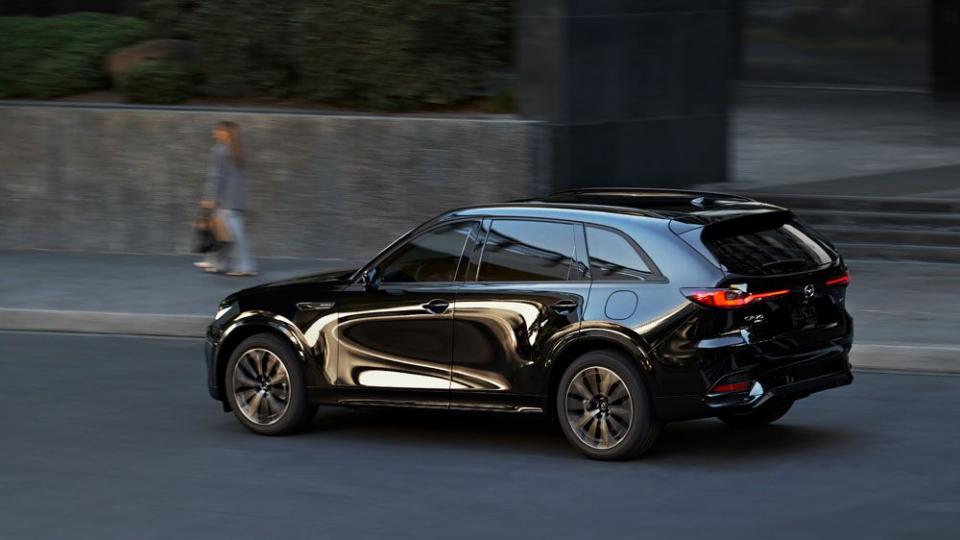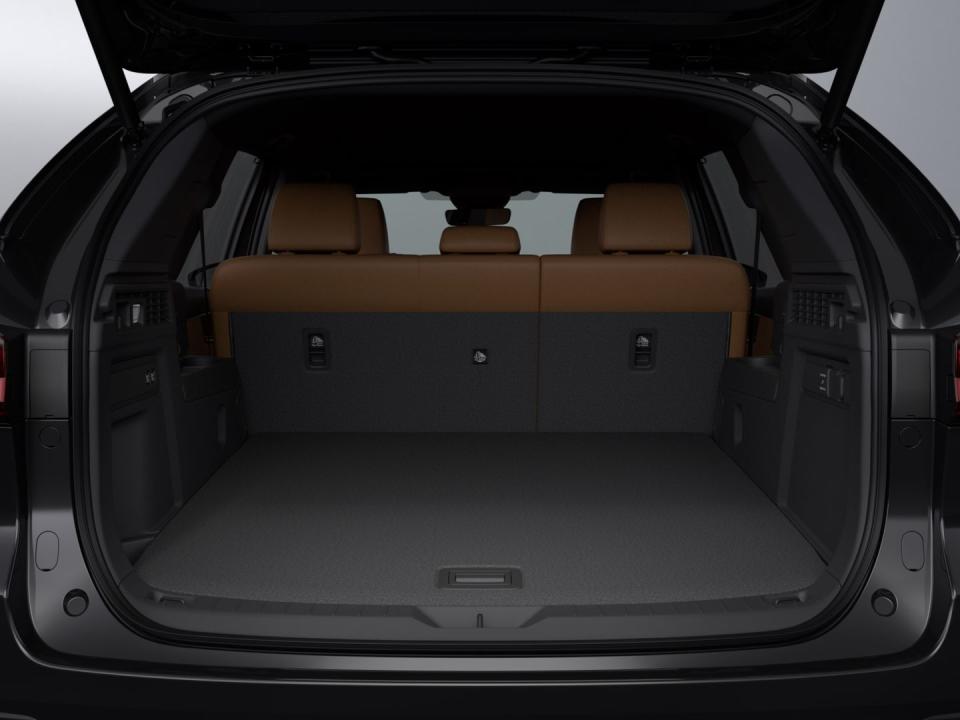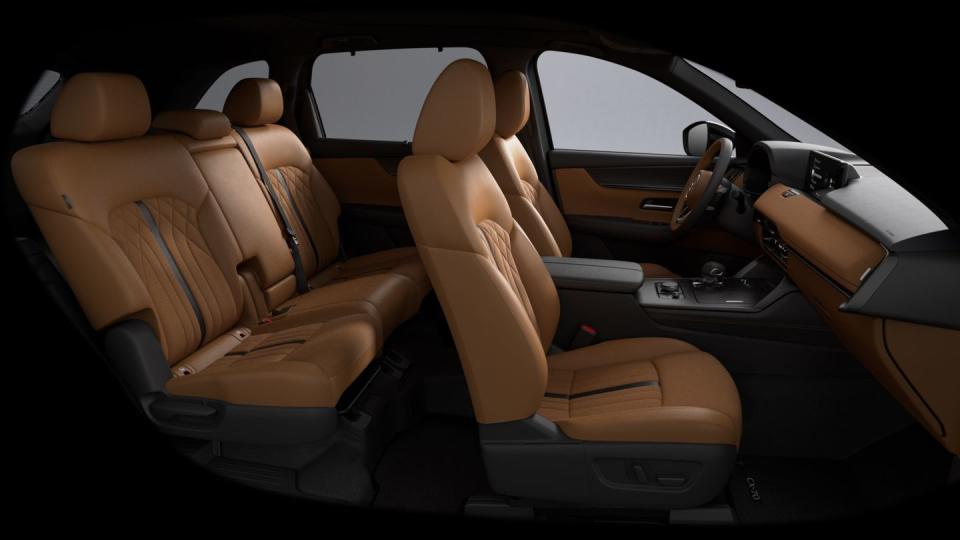2025 Mazda CX-70 Has Just Two Rows but a Cavern for Cargo Space

The 2025 Mazda CX-70 is mostly just a two-row version of the CX-90, with a big increase in cargo space for added utility.
The mid-size crossover competes with the likes of Kia Telluride, Honda Passport, and Toyota Grand Highlander, though Mazda lists more upscale luxury competitors.
Pricing ranges from $41,900 to $55,855.
SUV sales are now roughly 10 times that of what used to be called, simply, “cars,” and as such there is just about every size, shape, and serendipity you could ever want in the crossover market. If you’re in that 90% of buyers opting for this crossover configuration, you might as well get one that’s fun to drive.
Consider the 2025 Mazda CX-70. It’s carries the exact same measurements of its near-identical twin the CX-90 that came out last year, but inside, the CX-70 has only two rows of seats to the CX-90’s three. The upshot is you get more cargo space in the CX-70, which was an important consideration when Mazda was specing out its newest SUV.
“We want this to help bring in more customers to Mazda, attract a different customer that’s focused on that two-row configuration, and just get it on more shopping lists,” said Dan Aguilar, project manager of vehicle line planning for the Mazda CX-70. “With that, we were very intentional about the use of the cargo space.”

The CX-70 has more cargo room than several more upscale competitors, Aguilar said. It also has more cargo room than the CX-90: 39.6 cubic feet in the CX-70 over 14.9 cubic feet in the CX-90. If you fold down the second-row seats in the CX-70 you get 75.3 cubic feet of cargo room, enough to slide in a bicycle with the front wheel still on it, or for two people to sleep in the back (it’s not being marketed as a camper, but it could be used as such, Mazda says).
“This space can be utilized for that customer who wants that athletic leisure, or to support their hobbies, whether that’s gardening, road trips, sports, whatever that might be.”
(Gardening? It’s nice to see that Mazda never once used the term, “active lifestyle.” For that alone you should buy a Mazda.)
But the main draw of a CX-70 over any number of mid-size crossover competitors is that it’s surprisingly fun to drive, especially considering curb weights that range from 4,863 pounds to 5,198. Both CX-90 and CX-70 ride on the Mazda Large Platform. The setup is unique to Mazda and is not shared with any other manufacturer.
Both cars ride on double wishbones in front. Their longitudinally mounted engines allow for longer suspension arms that in turn allow for increased camber during cornering and can be tuned for better ride quality, Mazda said. Rear suspension is a five-link setup “to improve rear grip.”
Both are, indeed, fun to drive. Mazda does this sort of thing well. In addition to the double-wishbone front and five-link rear, the CX-90 and CX-70 have something called “Kinematic Posture Control” that applies brake force to the inside rear wheel during cornering for “a stable sensation on a winding road.”
Powering that nimble chassis is your choice of three engines. There are two versions of the 3.3-liter turbocharged straight-six available, as well as a 2.5-liter turbo-four aided by a plug-in hybrid-electric motor.
The PHEV makes 323 hp and 369 lb-ft of torque on premium gas and can go up to 26 miles on its 17.8-kWh electric battery alone. While it can only tow 3,500 pounds, all CX-70 PHEV models are equipped with Mazda’s Tow Mode, which, when engaged, monitors the load and prevents yaw for a more stable drive.
There are two versions of the 3.3-liter turbocharged straight-six. The standard model makes 280 hp and 332 lb-ft of torque, while the Turbo S Premium and Turbo S Premium Plus version of the 3.3-liter straight-six makes 340 hp and 369 lb-ft. The difference comes down to how long they leave the wastegate clamped shut.

The 3.3 Turbo Premium and above models come with a 5,000-pound towing capacity “when equipped with Mazda Genuine Towing Accessories,” which includes a transmission cooler.
The CX-70 3.3 Turbo has a starting sticker of $41,900, the CX-70 3.3 Turbo S starts at $53,905, and the CX-70 PHEV has a starting sticker of at $55,855.
So what was it like to drive, this new two-row CX-70? As we said, surprisingly fun for something that straddles the 5,000-pound mark.
My first drive on a twisty mountain road—the Palms to Pines Highway above Palm Springs, California—was in the loaded Turbo S Premium Plus version of the 3.3 straight-six making 340 hp and 369 lb-ft of torque. That thing hauled up the P-to-P like Wile E. Coyote was chasing it with dinner cutlery in each hand and a cloth napkin tied around his skinny neck.
Roll control is the most impressive thing on this ride, but torque, and then horsepower, were right up there, too. It’s not as nimble as a sedan, obviously, it’s 68.7 inches tall, but the reduced amount of lean compared to what you’d expect in a 4,863-pound SUV was impressive.
I also drove the four-cylinder plug-in hybrid on the same road. Its 323 peak hp and the same 369 lb-ft are very close to the output of the turbocharged straight-six, but the inline six-banger felt like it had more output across a wider band than the PHEV four.
Not that the hybrid lacked anything—that electric motor makes up so much low-end torque that Mazda didn’t bother to turbocharge the four-cylinder ICE engine and it still hits 323 hp at its 6,000-rpm peak. It’s just that the magic of the straight-six configuration has a perpetual draw. Ask anyone with a BMW.
So which should you buy? The non-hybrid costs less and offers more oomph, but the PHEV offers better fuel economy at an estimated 56 MPGe. Not a bad choice to have to make. As with the CX-90, Mazda didn’t provide a 0-60 mph time, but we’ll get a car for a more thorough test and come back and add it here asap. For now, trust in the torque, Luke.

 Yahoo Autos
Yahoo Autos 